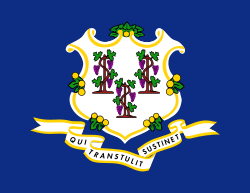Cape Cod Expressway
The Cape Cod Expressway is the name given to a highway that was proposed to have gone from New York City to Provincetown, Massachusetts. The road later became part of many highways and expressways, although it was never built and signed as a single road (and some portions never became highways).
| Cape Cod Expressway | |
|---|---|
| Route information | |
| Length | 260 mi (420 km) |
| Existed | 1953–1960s |
| Major junctions | |
| West end | New York, NY |
| East end | Provincetown, MA |
| Location | |
| States | New York, Connecticut, Rhode Island, Massachusetts |
| Highway system | |
Route description
_map.svg.png)
Coming out of New York City, the route would have followed Interstate 95 along the modern New England Thruway until the Connecticut border, where it would meet up with what later became the Connecticut Turnpike. Once it reached Rhode Island, the expressway would follow the present-day Route 138 to Route 24, Interstate 195 (where it would cross into Massachusetts), Route 25, and U.S. Route 6 all the way to Provincetown, Massachusetts.[1][2]
History
During the early second half of the 20th century, states began to experience traffic congestion affecting local roads. In response, many states began building expressways in order to alleviate this congestion. In 1953, the governors of New York, Connecticut, Rhode Island, and Massachusetts began to plan a 260-mile-long (420 km) expressway that would link New York City to Provincetown, Massachusetts. The highway was projected to cost around $75 million, and would be between four and six lanes wide. Tolls would be charged for parts of the highway, although the road as a whole would not be tolled. The route was billed as "the most direct and shortest highway route between the present and potentially major urban-industrial and recreational concentrations, and between significant military installations of the shore route area."[1]
The route was built as planned from New York City into Rhode Island. Because of highway revolts, the route along Route 138 to Route 24 ended up not being completed (both roads were also concurrently signed with Interstate 895 at one point, as well).[1] In Massachusetts, the Charles M. Braga Jr. Memorial Bridge, which carries Interstate 195, was built with the eventual aim of carrying the expressway.[3] Route 25 in Massachusetts would eventually be constructed along the proposed route of the expressway. In Bourne, plans for the expressway turned into the Southside Connector which was planned around the same time as the expressway, but also never built.[2] On Cape Cod, the road turned into the Mid-Cape Highway and was constructed as an expressway as far as the Orleans Rotary. Because the road served as a main thoroughfare for towns north of Orleans, the expressway idea likely was abandoned, although between North Truro and Provincetown, grade-separated interchanges were constructed in remote sections.[4]
See also






References
- Anderson, Steve (2013). "Connecticut Turnpike: Historic Overview". Eastern Roads. Self-published. Retrieved February 25, 2013.
- Anderson, Steve (2009). "MA 25 Expressway-Historic Overview". Eastern Roads. Self-published. Retrieved February 24, 2013.
- Anderson, Steve (2013). "Charles Braga Bridge (I-195)". Boston Roads. Self-published. Retrieved February 25, 2013.
- Anderson, Steve (2013). "Mid-Cape Highway (US 6)". Boston Roads. Self-published. Retrieved February 25, 2013.
Further reading
- "Expressway Discussed by Governors". The Hartford Courant. Associated Press. June 19, 1953. p. 2. (subscription required)
- "New England Road Project Backed". The New York Times. October 29, 1953. p. 19. (subscription required)
- "Across the Map: Limited-Access Highways Spreading Rapidly from Maine to the Midwest". The New York Times. June 20, 1954. p. XX21. (subscription required)